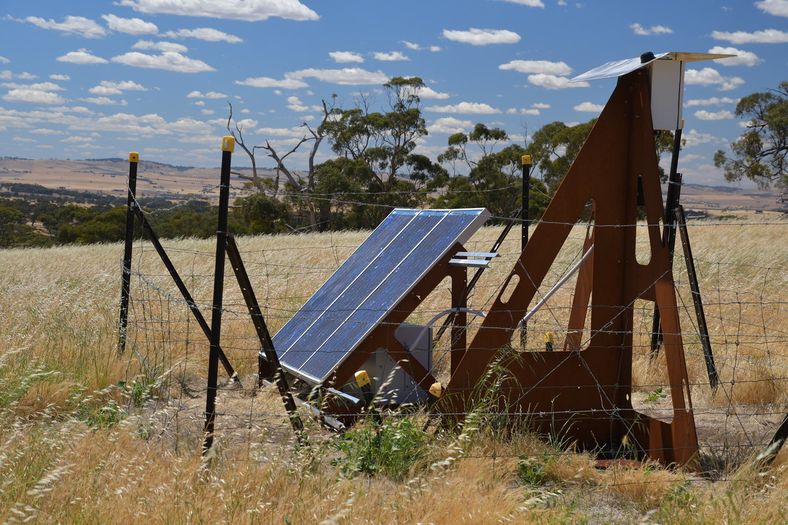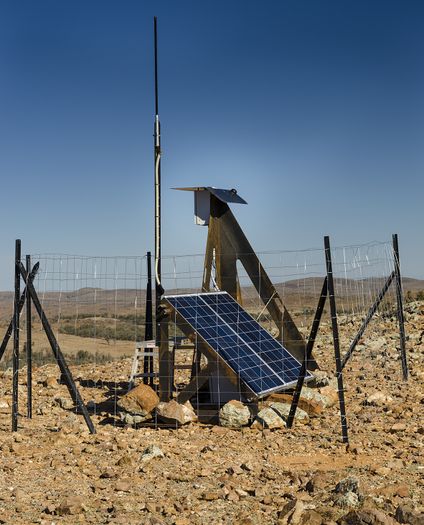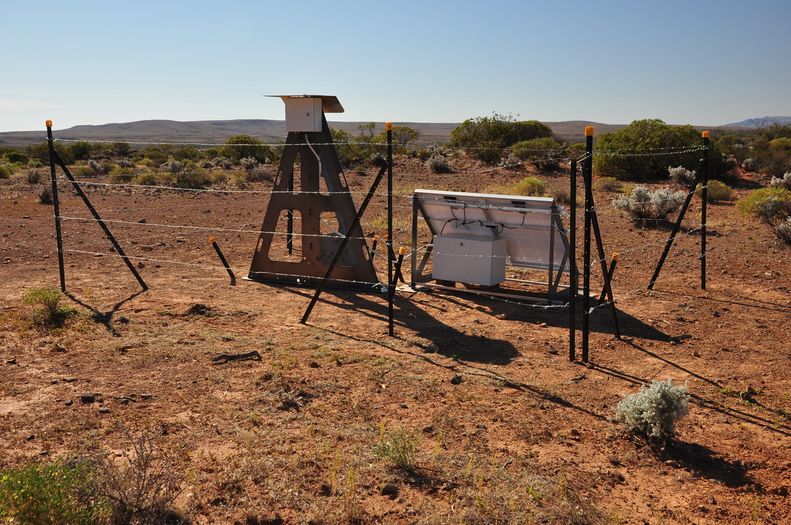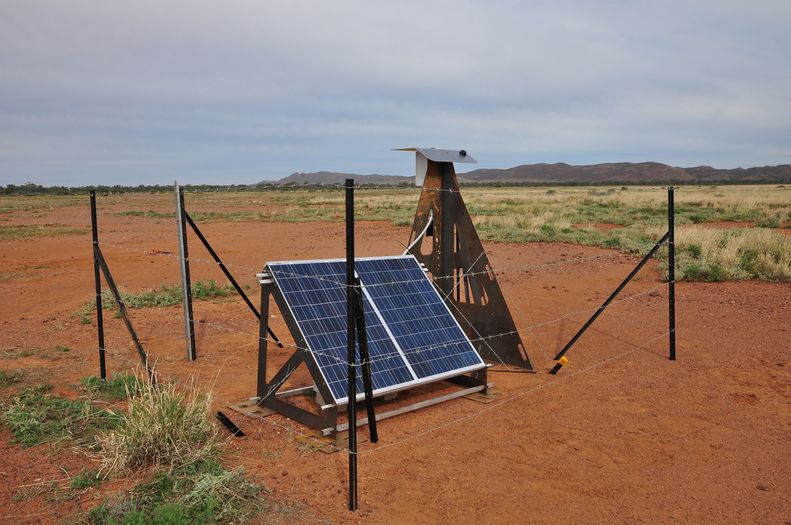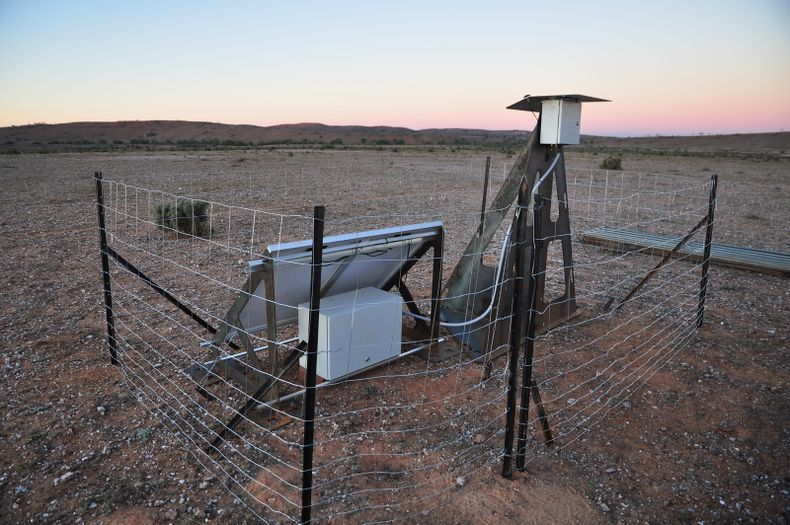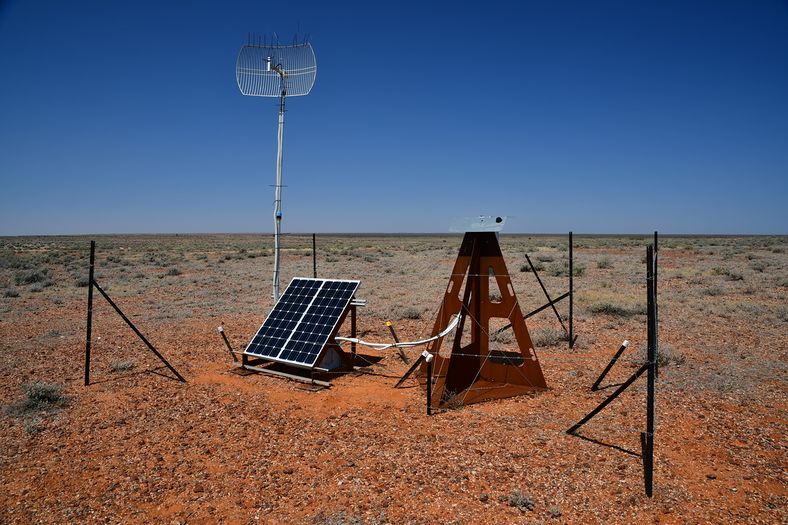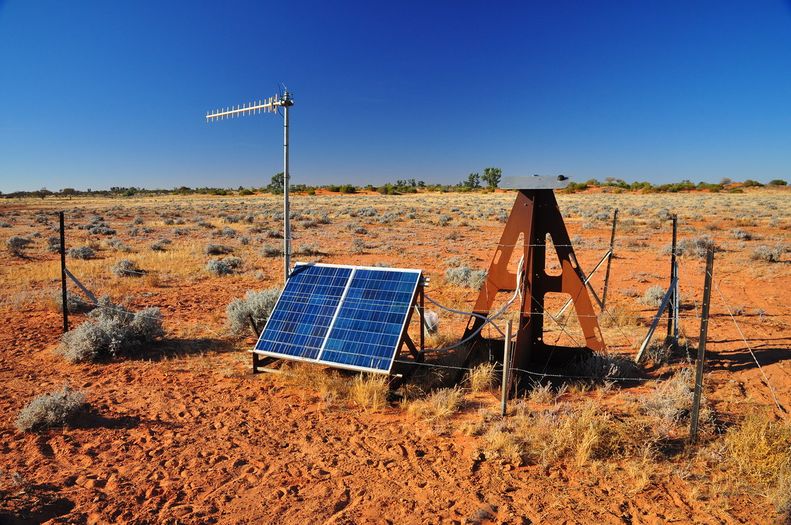Standalone Fireball Camera Installation
Observatory Stand Assembly
At least two people are recommended for assembling the stand.
- Place stand base on four blocks or bricks ensuring there is clearance for the rib and back's tabs.
- Place stand back on top of base and insert tabs.
- Lean stand back outwards and insert stand rib. You may have to wiggle the pieces until they fall into place.
- Start inserting wedges staring from the corners. Do the top first and then start on the bottom corners. It may be helpful to tilt the stand over a bit or lay it down on its side.
- Once the wedges are are all securely inserted, wire up the four fencing wire cross stays and tension by twisting using a large screwdriver.
- Align stand so stand back is facing south (in the Southern Hemisphere, north in the Northern Hemisphere).
- Stake down the stand in soft soil or weigh down the stand using rocks or sandbags. As the centre of mass is not over the centre in the base, it is not safe to leave the stand without weight or stakes.
Solar Panel Stand Assembly
- Assemble solar panel stand using aluminium angle bar, wedges, panels and self tapping fasteners (Tek Screws).
- Add sand shoes in soft soil
- Stake or weigh down solar panel stand.
Power System
Components:
- Enclosure
- Deep cycle battery
- Solar charge controller
- Solar panel(s)
- Fuses and fuse holders for load and battery if not provided by solar charge controller
- Wire for connections
- Cable glands or panel mount connectors
- DFN observatory power connector
Enclosure
The B&R Forte FR060430 has been used for all previous solar powered DFN observatory installations (unless there is an existing power supply). It is available from electrical wholesalers (e.g. Advanced Electrical Equipment, Electrical Distributors, MM Electrical Merchandising) or at a higher price from RS Components.
Deep Cycle Battery
The recommended battery for the DFN fireball observatories is a 140-180 AH deep cycle lead acid battery. This is the same sort of battery you would use to run a fridge in an RV or boat. AGM (absorbant glass mat) or gel constructions are fine. The DFN uses 165 or 175 AH AGM deep cycle batteries. Ensure that the battery will fit inside the Forte FR060430 with the solar charge controller. (Usable internal dimensions are a bit less than 600x400x300 mm.)
Good suppliers include:
It is worth ordering in bulk and obtaining multiple quotes to secure a good price. Lead acid batteries will degrade if not kept charged, so it is worth charging any batteries you have in storage about every six months.
When used in a solar power application it is best to keep the depth of discharge of lead acid batteries to 30% or less to prolong the cycle life of the battery.
Solar Charge Controller
A maximum power point tracking charge controller will allow you to use much better value 200-360W 60 or 72 cell solar panels designed for rooftop use and available as low as $0.50 per Watt instead of 12V 65-150W solar panels designed for camping which are much more expensive (around $2 per Watt).
The Victron Energy BlueSolar MPPT 75/15 would be a good option that seems like good value at around $130. You will also need a Bluetooth smart dongle or USB cable to program the battery charging voltages on the charge controller (about $90 or $50 respectively).
The DFN has used the SunSaver SS-20L-12V with three 80-100W panels for most of its installs, but this configuration is no longer recommended due to the high cost of 12V panels compared to 60 or 72 cell panels.
Solar Panel(s)
A single polycrystalline panel of at least 275W is recommended. We would recommend considering the Jinko Solar JKM275PP-60 which is very good value at $0.46/W. We have used the Jinko Solar JKM270PP-60 to power all of our off-grid FireOpal SSA observatories.
Fuses and Fuse Holders
The power system should be protected by two 25A automotive blade fuses placed in line with the battery and load (observatory) using blade fuse holders (unless protection is provided by the solar charge controller—as is the case with the Victron Energy BlueSolar MPPT 75/15).
Wire for connections
Use ≈10 AWG cable for wiring inside the battery box. Wire can be purchased from electronics shops such as Altronics or Jaycar, or from electronic components distributors such as Mouser (Red, Black).
For exterior solar panel connections use 4mm2 UV resistant solar cable. You will also need MC4 connectors and the correct crimp tool. Pre-terminated cables are also available.
Cable glands or panel mount connectors
You will need to use cable glands or panel mount MC4 connectors (Male, Female) to wire the solar panels up to the battery box and charge controller.
The Amphenol MS3102A 14S-2P is used on the battery box and the DFN observatory for the observatory power cable. The correct gasket will have to be purchased separately. The mating connector which is used on the observatory power cable is MS3106F 14S-2S.
Setting up:
orientation
On the Southern hemisphere, the solar panels shall face North, while the observatory box doors shall face south. On the Northern hemisphere it is obviously the other way around.
<pic of whic way should be north>
heat shield
north or south hemisphere
gps
cables and connections
wifi, 3G, ethernet
blah
Example DFN design
System as used by DFN below. you can do other designs, the important criteria for a power system is it must provide <XX> Amp-hours per day, reliably:
stand assembly
<pic>
panels
<pic>
battery box and cabling
<pic>
